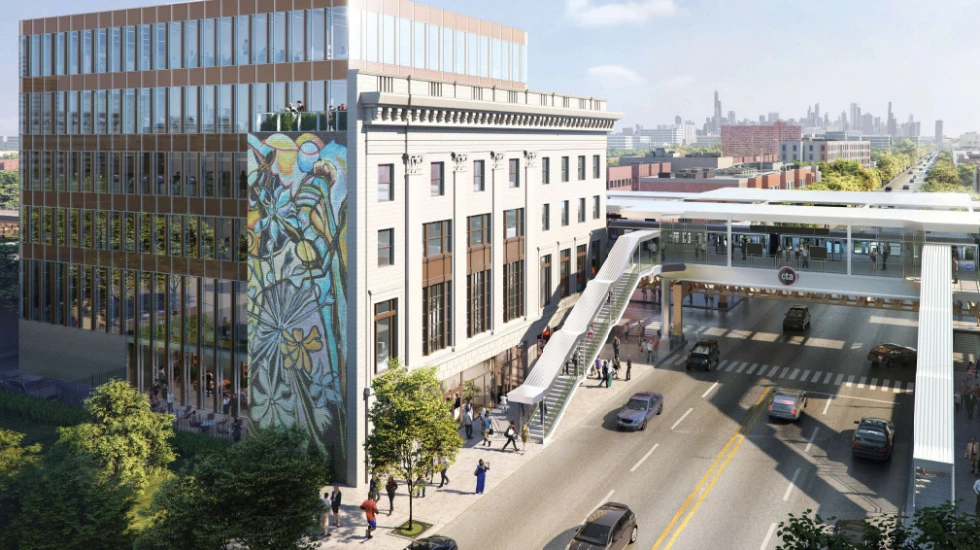
In January 2020, developer Leon Walker was eager to start a project that could have heralded a turnaround for the Woodlawn community on the South Side. He was anxious to close on a deal for a decrepit but well-located old bank building at the southwest corner of 63rd Street and Cottage Grove Avenue.
Walker could not have known then that we were on the tail end of “before times,” when commerce was smoother and the world seemed less careworn.
“The pandemic was a complete full stop,” said Walker, managing partner of DL3 Realty. Once the coronavirus hit, upending daily life, lenders were unwilling to back real estate deals that weren’t a cinch. And 63rd and Cottage Grove was certainly a speculative proposition.
So the vacant building had to stay that way, a blight on a heavily trafficked corner with an L stop, for a while longer. Walker had to shelve his plan to demolish it for a new office and retail building.
The veteran developer, with many successes on the South Side, said people who wanted the old building saved were unrealistic. The property remained in the hands of the Cook County Land Bank Authority, whose mission is to encourage development of difficult properties, especially in poor areas.
Eleanor Gorski took over as executive director of the land bank last year and took a fresh look at the property. An architect and former staff member at Chicago’s Planning Department, Gorski kept in touch with Walker because the land bank felt he had submitted the best proposal when it advertised the property’s sale. She used the pandemic pause to urge Walker to think anew.
“I wanted the whole building preserved. The numbers just didn’t allow it. And yet, it’s such an iconic structure in the neighborhood,” Gorski said.
The numbers penciled out for that old friend of disparate views: the compromise. Walker has agreed to preserve the building’s limestone façade and its once elegant windows and entrances. Behind the five-story façade would be new construction, about 75,000 square feet, for offices Walker wants to market to neighborhood entrepreneurs.
“This is the thing that’s exciting. Not one Class A office building has opened on the South Side in 30 years,” Walker said, using the term that means the most modern space. He said many people have approached him about renting quarters for a small business in Woodlawn, which has gotten attention from the plans for the Obama Presidential Center in Jackson Park.

Walker has retained bKL Architecture for the new plan, which will be shown to the community later this month. Feedback there could change things. But Gorski said if all goes well, she hopes the land bank’s board can approve the property’s sale in June. She and Walker said the price is yet to be settled. Construction could start late this year and be done in 2024, Walker said.
Architectural enthusiasts and many in the area had wanted the neoclassical design from 1924 to be saved. It was originally the Washington Park National Bank. In its prime, it projected class and stability at a neighborhood crossroads, like the bank buildings of yore in other parts of Chicago. But this bank, like many others, had trouble in the Depression and eventually disappeared. As the neighborhood declined, so did the building.
It’s been empty for years. Its skylit atrium caved in long ago. Those who have been through the ruins describe it as like a setting for a dystopian movie. The group Preservation Chicago has researched the building’s history and placed it on its “most endangered” lists.
The site is in the 20th Ward of Ald. Jeanette Taylor, who said she’s glad a project is finally moving forward. She awaits details and suggested a restaurant or bank branch — how fitting — would be a suitable ground-floor tenant. Walker said he is working with the restaurant industry and World Business Chicago in finding users.
He would replace the old atrium with wider floors for offices geared to today’s demand. The building’s original offices were off narrow corridors built around the atrium in a C shape. You could imagine them having a dentist, lawyer or insurance agent long ago. A consultant’s report for the land bank in 2018 concluded the façade was sound and salvageable.
“We’re committed to this. We’ve been through several iterations of our plan during COVID. This will be an awesome addition to that intersection,” Walker said. He would use the traditional architecture as a marketing tool. “We’re in the business of selling space, and we have to make that space attractive to the user,” he said.
His swing toward preservation is a change of heart, yes, but possibly good for a neighborhood’s soul.








